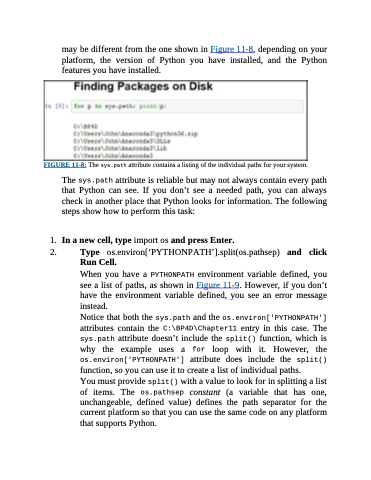Page 249 - Beginning Programming with Pyth - John Paul Mueller
P. 249
may be different from the one shown in Figure 11-8, depending on your platform, the version of Python you have installed, and the Python features you have installed.
FIGURE 11-8: The sys.path attribute contains a listing of the individual paths for your system.
The sys.path attribute is reliable but may not always contain every path that Python can see. If you don’t see a needed path, you can always check in another place that Python looks for information. The following steps show how to perform this task:
1. Inanewcell,typeimportosandpressEnter.
2. Type os.environ[‘PYTHONPATH’].split(os.pathsep) and click
Run Cell.
When you have a PYTHONPATH environment variable defined, you see a list of paths, as shown in Figure 11-9. However, if you don’t have the environment variable defined, you see an error message instead.
Notice that both the sys.path and the os.environ['PYTHONPATH'] attributes contain the C:\BP4D\Chapter11 entry in this case. The sys.path attribute doesn’t include the split() function, which is why the example uses a for loop with it. However, the os.environ['PYTHONPATH'] attribute does include the split() function, so you can use it to create a list of individual paths.
You must provide split() with a value to look for in splitting a list of items. The os.pathsep constant (a variable that has one, unchangeable, defined value) defines the path separator for the current platform so that you can use the same code on any platform that supports Python.


